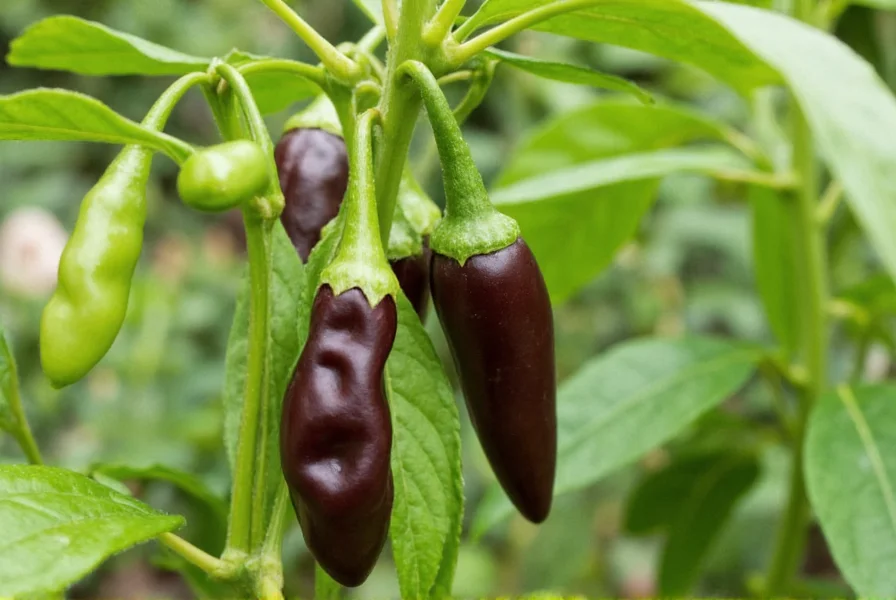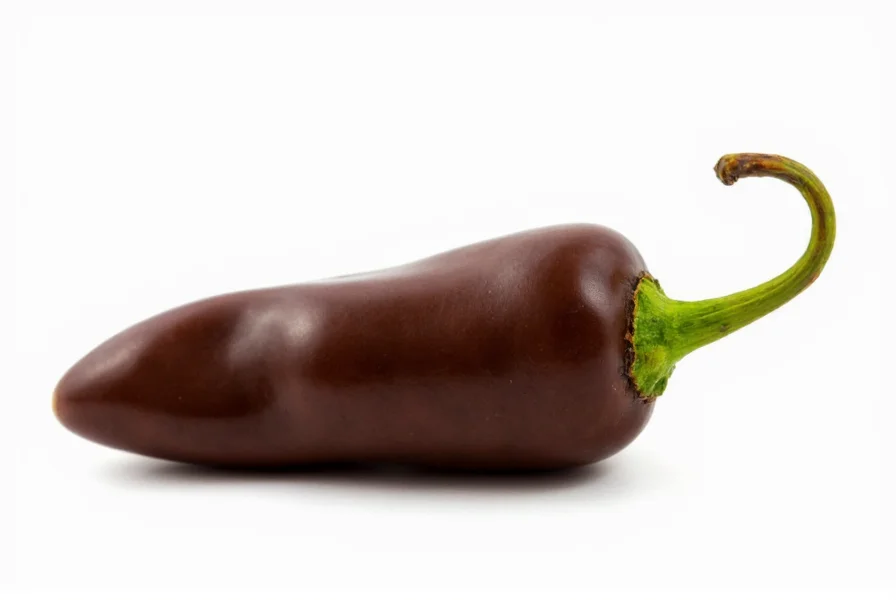When gardeners and food enthusiasts search for chocolate pepper information, they're typically seeking details about this unique chili variety that stands out from common red or green peppers. Unlike regular bell peppers, chocolate peppers develop their signature dark hue as they ripen, creating visual appeal alongside their distinctive taste.
Understanding Chocolate Pepper Characteristics
Chocolate peppers belong to the Capsicum chinense species, sharing lineage with habaneros but offering significantly milder heat. The mature pods measure between 2,500-5,000 Scoville Heat Units (SHU), placing them in the same heat range as poblano peppers rather than their fiery cousins.

What makes chocolate peppers particularly interesting to chocolate pepper growers is their color transformation process. They begin as green peppers, transition through purple and burgundy stages, and finally develop their characteristic chocolate-brown color when fully ripe. This color change indicates peak flavor development, with the sugars fully concentrated and the complex flavor profile at its best.
Chocolate Pepper Varieties and Origins
The most well-known variety is the Chocolate Habanero, sometimes called Black Habanero or Dark Habanero. Despite the habanero name, these peppers offer only a fraction of the heat of traditional orange habaneros (which range from 100,000-350,000 SHU).
Other notable varieties include:
- Chocolate Bhut Jolokia - A milder version of the infamous ghost pepper
- Chocolate Trinidad Scorpion - Another reduced-heat superhot variety
- Chocolate Bell Pepper - A sweet pepper variety with dark coloration (not spicy)
These peppers originated in tropical regions where growing chocolate peppers conditions naturally support Capsicum chinense species. Today, specialty seed companies offer chocolate pepper varieties to gardeners worldwide, though they require warm temperatures and long growing seasons to reach maturity.
Culinary Applications of Chocolate Peppers
Chefs value chocolate peppers for their chocolate pepper flavor profile that combines:
- Subtle smokiness
- Fruity undertones
- Earthy notes
- Mild heat that enhances rather than overwhelms
| Pepper Variety | Heat Level (SHU) | Color at Maturity | Flavor Characteristics |
|---|---|---|---|
| Chocolate Pepper | 2,500-5,000 | Dark Brown | Smoky, sweet, earthy |
| Regular Habanero | 100,000-350,000 | Orange | Fruity, citrusy, very hot |
| Poblano | 1,000-2,000 | Dark Green | Earthy, mild |
| Jalapeño | 2,500-8,000 | Green/Red | Grassy, bright |
Professional kitchens use chocolate peppers in applications where incorporating chocolate pepper in recipes adds complexity without overwhelming heat. They work particularly well in:
- Salsas and hot sauces seeking depth of flavor
- Chocolate-based savory dishes (yes, chocolate and chocolate pepper work well together)
- Roasted vegetable medleys
- Specialty meat rubs
- Infused oils and vinegars
Growing Chocolate Peppers Successfully
For gardeners interested in how to grow chocolate peppers, these plants require similar conditions to other Capsicum chinense varieties:
- Start seeds indoors 8-10 weeks before last frost date
- Require soil temperatures of at least 70°F (21°C) for germination
- Need 90-120 days to reach maturity from seed
- Prefer well-draining soil with consistent moisture
- Benefit from balanced fertilizer during flowering and fruiting

One common challenge for chocolate pepper cultivation is the extended time needed for the peppers to develop their characteristic color. Many gardeners harvest too early, missing the full flavor development that occurs during the color transition phase. Patience yields significantly better results when growing this variety.
Storage and Preservation Methods
Preserving your chocolate pepper harvest properly maintains their unique qualities. The best methods include:
- Drying - String peppers or use a dehydrator at 135°F (57°C) until brittle
- Freezing - Chop and freeze in oil for cooking applications
- Pickling - Creates flavorful additions to charcuterie boards
- Infusing - Add to vinegar, oil, or spirits for specialty ingredients
Dried chocolate peppers retain their distinctive color better than many other varieties, making them visually appealing in dried arrangements or when ground into flakes. When properly stored in airtight containers away from light, dried chocolate peppers maintain their flavor for up to two years.
Common Misconceptions About Chocolate Peppers
Several misunderstandings persist about this unique variety:
- They contain chocolate - Despite the name, chocolate peppers contain no cocoa products
- They're extremely hot - Most varieties are medium heat, not superhot
- All dark peppers are chocolate peppers - Many pepper varieties develop dark colors
- They taste like chocolate - The name refers to color, not flavor profile
Understanding these distinctions helps both gardeners and cooks make informed decisions when selecting chocolate pepper varieties for home gardening or culinary use. The name refers strictly to the visual appearance of the mature fruit, not to any chocolate flavor or ingredients.
Frequently Asked Questions
What exactly is a chocolate pepper?
A chocolate pepper is a specific variety of chili pepper (typically Capsicum chinense) that develops dark brown to chocolate-colored pods when fully mature. Despite the name, it contains no chocolate and refers only to the color of the ripe pepper. These peppers typically range from 2,500-5,000 Scoville Heat Units, offering mild to moderate heat with complex smoky-sweet flavor notes.
How hot are chocolate peppers compared to other varieties?
Chocolate peppers measure between 2,500-5,000 Scoville Heat Units (SHU), making them significantly milder than habaneros (100,000-350,000 SHU) despite some varieties carrying "habanero" in their name. They're comparable to jalapeños in heat level but offer a more complex flavor profile with smoky and earthy notes rather than the grassy flavor of jalapeños.
Can I grow chocolate peppers in a cooler climate?
Yes, but with some considerations. Chocolate peppers require warm temperatures and a long growing season (90-120 days). Gardeners in cooler climates should start seeds indoors 8-10 weeks before the last frost, use black plastic mulch to warm the soil, and consider growing in containers that can be moved to sunny locations. Providing consistent warmth (soil temperatures above 70°F/21°C) significantly improves success rates for growing chocolate peppers outside tropical regions.
What's the best way to use chocolate peppers in cooking?
Chocolate peppers shine in applications where their complex flavor can enhance dishes without overwhelming heat. Try them roasted and blended into chocolate mole sauce, finely diced in fruit salsas, infused in olive oil for dipping bread, or added to chocolate-based savory dishes. Their mild heat makes them versatile for adding depth to dishes where traditional hot peppers would be too intense. For best results, use fully ripe chocolate-colored peppers rather than green immature ones.
Why do my chocolate peppers stay green instead of turning brown?
Chocolate peppers require time and proper conditions to develop their characteristic color. If your peppers remain green, they likely need more time to mature. These varieties typically take 90-120 days from seed to full maturity. Ensure they receive adequate sunlight, consistent moisture, and warm temperatures. The color transition happens gradually through purple and burgundy stages before reaching chocolate brown. Harvesting too early prevents the full development of both color and flavor complexity.











 浙公网安备
33010002000092号
浙公网安备
33010002000092号 浙B2-20120091-4
浙B2-20120091-4